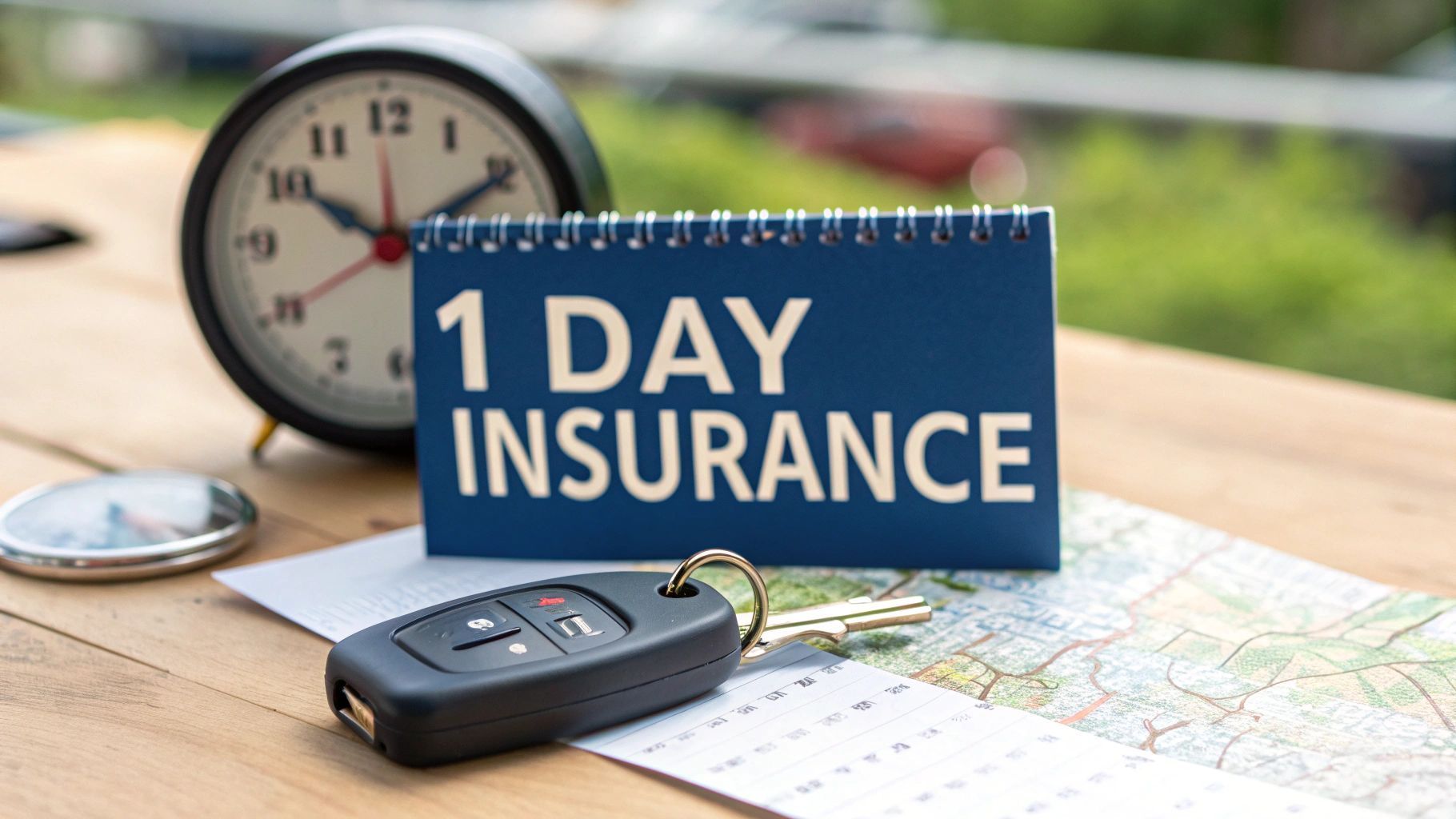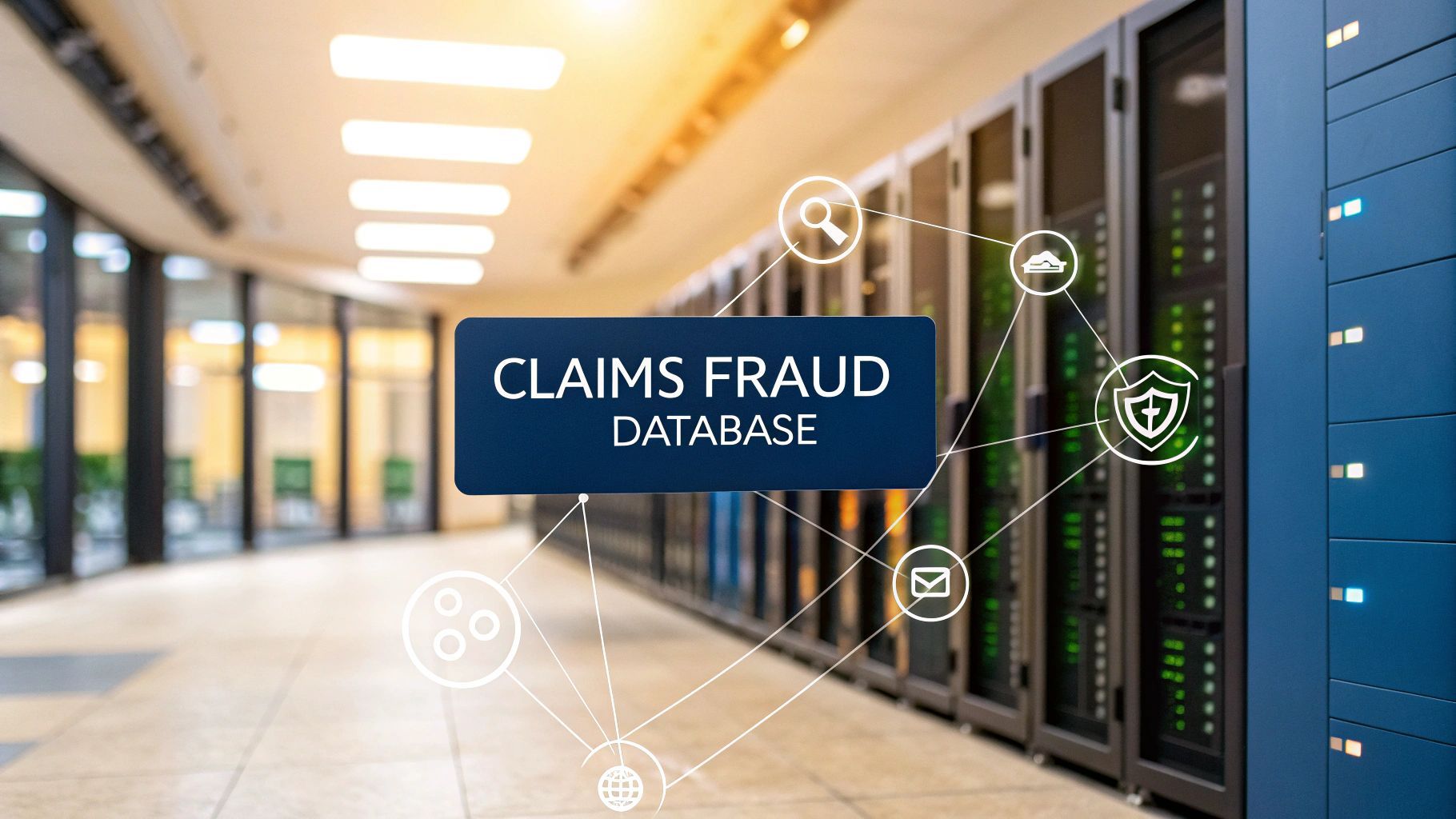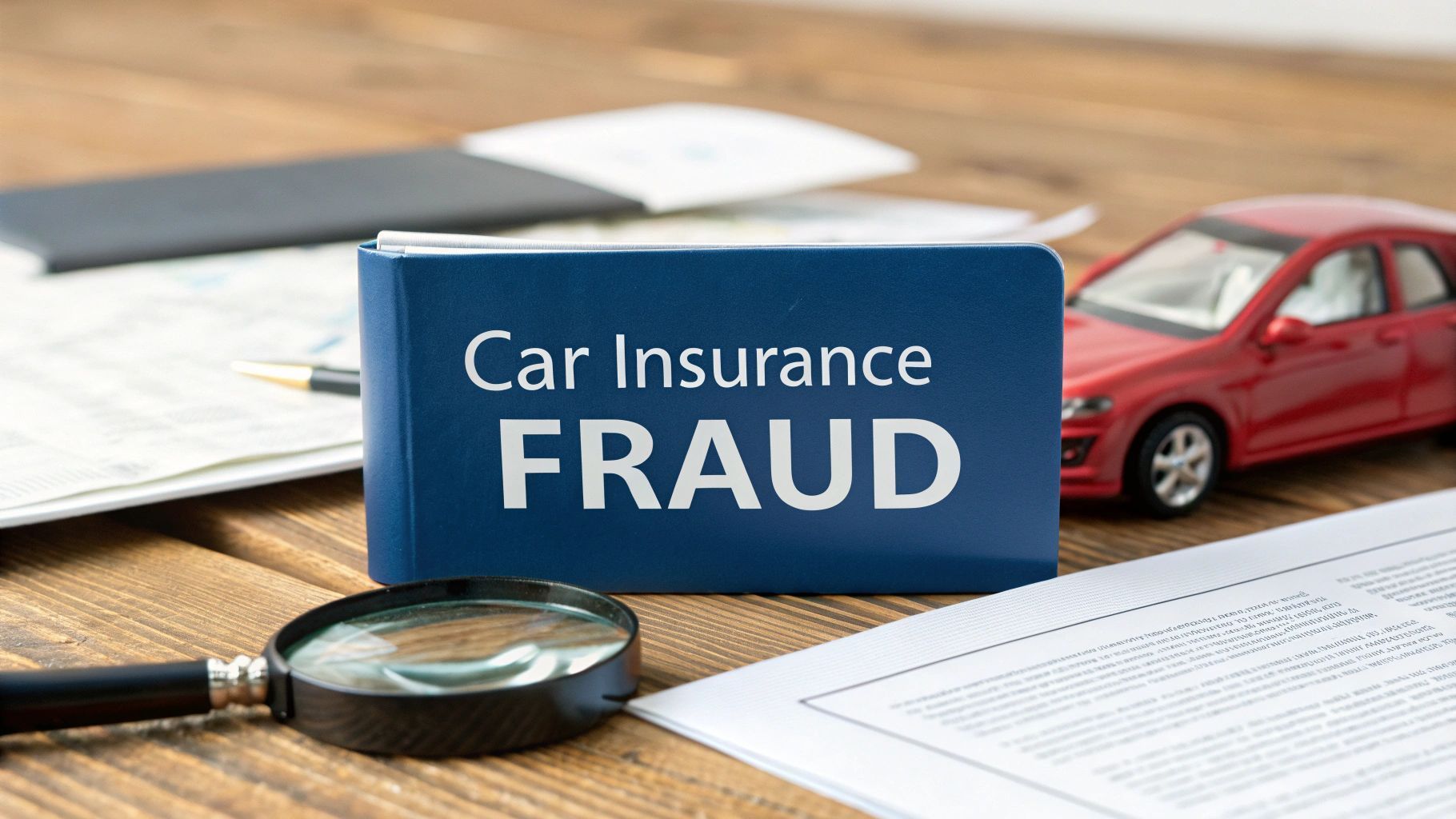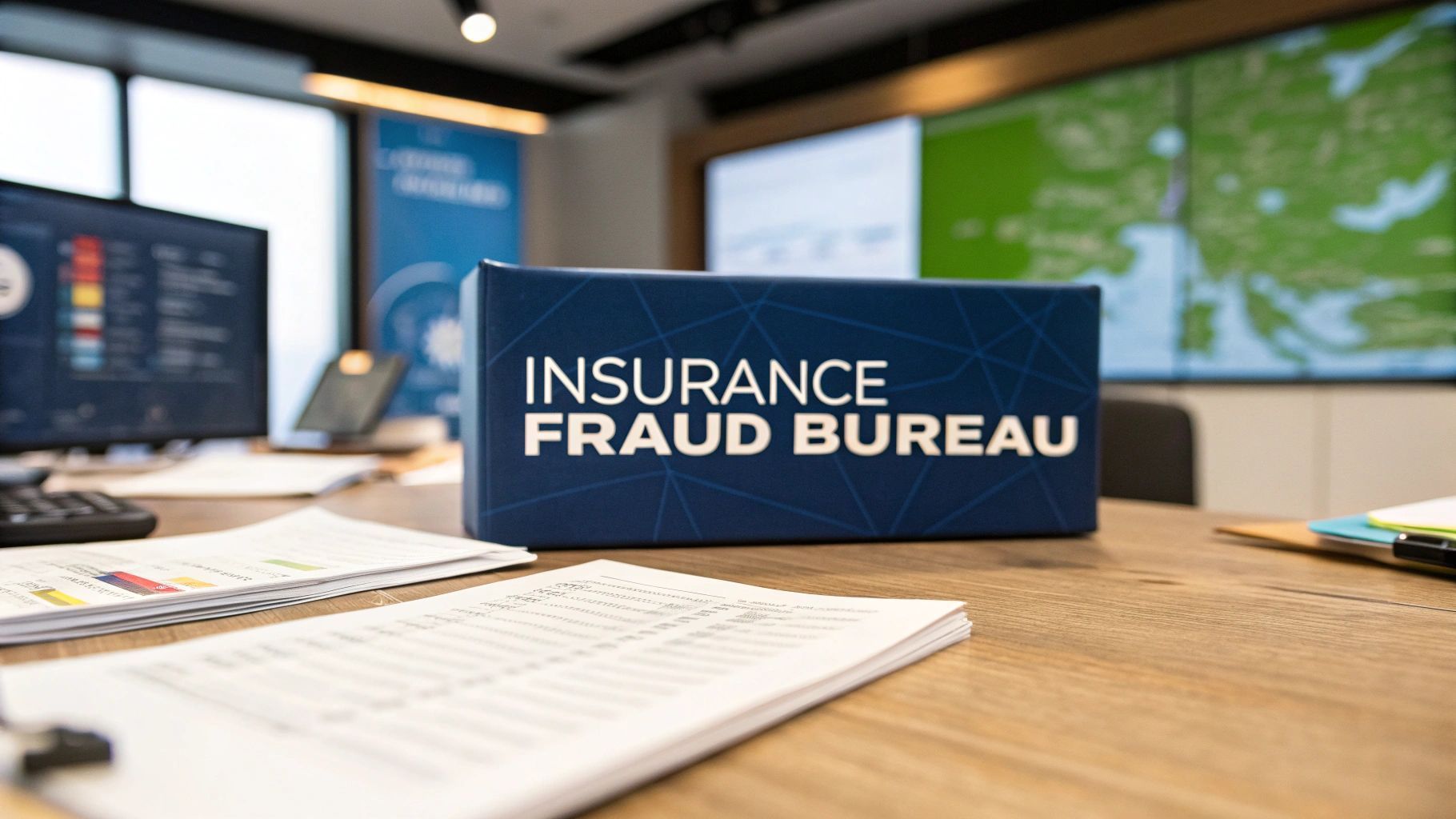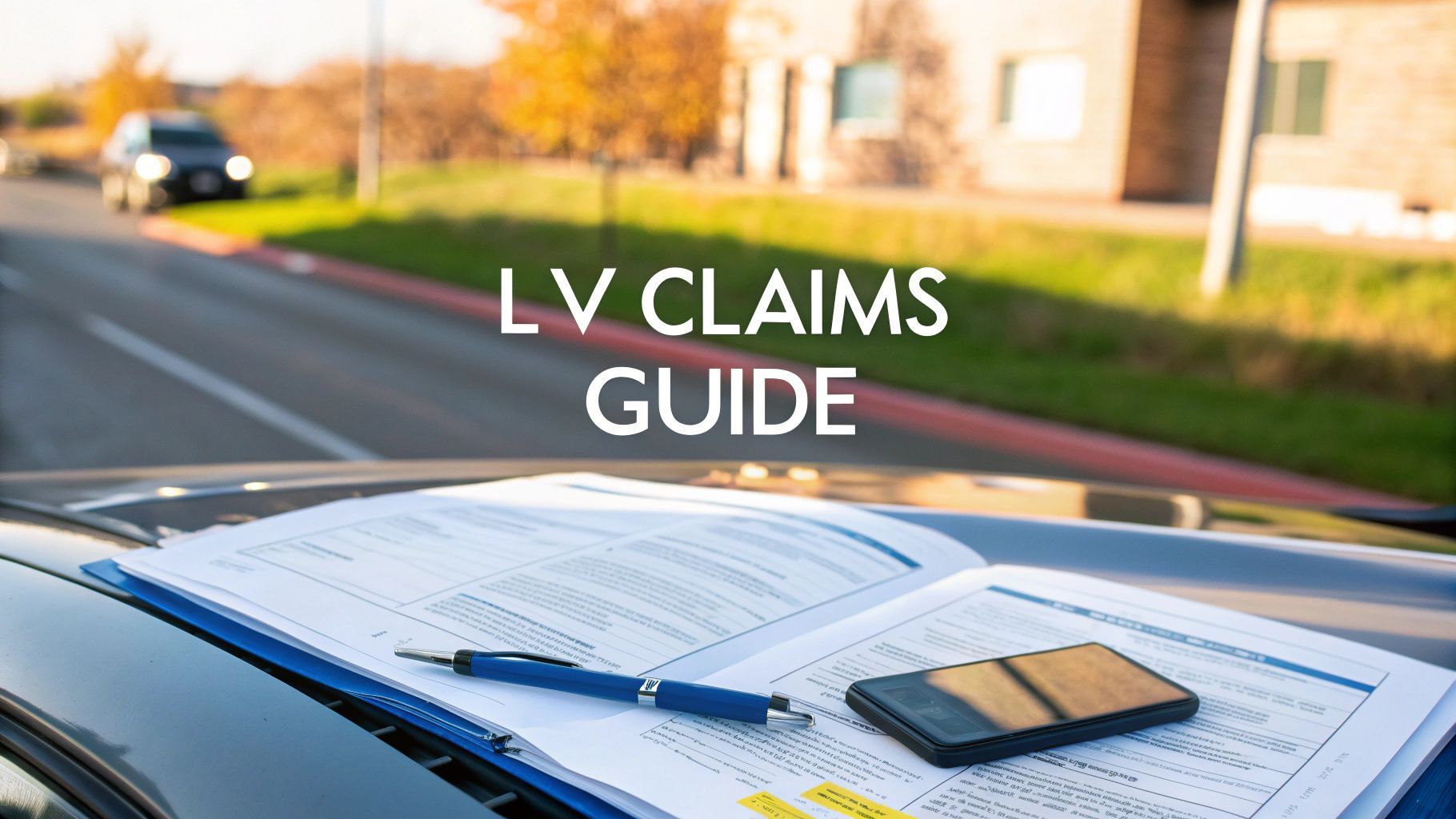A Guide to Fraud Prevention Insurance for UK Businesses
Fraud prevention insurance is not a specific policy one can purchase. Instead, it refers to the comprehensive system of strategies, technologies and protocols that insurers employ to detect and prevent fraudulent activity before it costs everyone money. Think of it as a proactive defence, one that protects both the insurance company and its honest customers from the fallout of fake or exaggerated claims. Proving the validity of claims is absolutely essential for keeping premiums fair for all.
Why Insurance Fraud is Everyone's Problem

It is tempting to view insurance fraud as a victimless crime—a small untruth told to a massive, faceless corporation. But that could not be further from the truth. Every single fraudulent claim that is paid out is a cost the industry must absorb and these costs are inevitably passed on to every policyholder through higher premiums. The provability of a claim is paramount.
You can think of it as an undeclared tax. A dishonest minority games the system and the honest majority is left to foot the bill. This hidden "fraud tax" makes your car, home and business insurance more expensive than they need to be. The cost to the industry is enormous. The problem is not just about small-time opportunists adding a few extra pounds to a claim; it involves sophisticated criminal networks staging accidents or creating fake policies on an industrial scale.
The Staggering Financial Burden
The sheer scale of insurance fraud in the UK is breathtaking. In 2022 alone, insurers detected over £1.1 billion in fraudulent claims, uncovering a staggering 72,600 dishonest claims . Even more alarmingly, it is estimated that a similar amount slips through the net undetected each year, which shows just how deep the problem runs and the cost to all of us.
To fight back, insurers are forced to spend at least £200 million annually on fraud prevention. This constant financial drain sends ripples across the economy. It forces insurers to be more cautious, which can mean longer processing times for legitimate claims as more stringent checks are put in place. For a business, a delayed payout can seriously disrupt cash flow and stall operations. The need for robust fraud prevention has never been more urgent.
By tackling fraud head-on, insurers not only protect their own bottom line but also fulfil their duty to keep premiums fair for the vast majority of honest customers who rely on them for financial protection.
The reality is that fraud creates a ripple effect, touching everyone from individual policyholders to large corporations. The table below breaks down how these costs are felt across the board.
The True Cost of Insurance Fraud
| Stakeholder | Direct Impact | Indirect Impact |
|---|---|---|
| Honest Policyholders | Higher annual premiums for car, home and business insurance. | Slower claim processing times due to increased verification steps; reduced trust in the insurance system. |
| Insurers | Financial losses from paying out fraudulent claims; significant operational costs for fraud detection teams and technology. | Reputational damage if fraud is widespread; increased regulatory scrutiny and compliance burdens. |
| Small & Medium Businesses | Increased insurance costs impacting overheads and profitability. | Delays in legitimate claim payouts can disrupt cash flow, hindering operations and growth. |
| Society at Large | Strain on emergency services and law enforcement responding to staged incidents; supports organised crime networks. | A general increase in the cost of goods and services as businesses pass on higher insurance expenses to consumers. |
As you can see, the direct financial hit is just the beginning. The indirect consequences—from operational delays to a breakdown in trust—are just as damaging.
Who Commits Insurance Fraud?
To build an effective defence, you first need to understand who you are up against. Fraudsters are not a single, uniform group; they generally fall into two distinct camps:
- Opportunistic Fraudsters: These are everyday policyholders who spot a chance to bend the truth on a legitimate claim. It could be as simple as adding a non-existent laptop to a burglary claim or exaggerating the severity of whiplash after a minor road accident.
- Organised Criminals: This is fraud on a professional level. These groups operate with methodical precision, running complex schemes like "crash for cash" scams or "ghost broking," where fake insurance policies are sold to unsuspecting drivers. Our guide on insurance fraud as a growing concern for businesses dives deeper into these organised schemes.
Uncovering Common Insurance Fraud Schemes

To build a truly effective defence, you first need to understand the enemy. In insurance, this means getting to grips with the specific tactics criminals use to exploit the system. Fraud is not one single problem; it is a whole collection of different schemes, from casual exaggerations to sophisticated, organised crime.
By dissecting these common approaches, we can start to see the patterns and spot the red flags. Think of it as learning the playbook. Once you know the plays, you can anticipate the moves and build a much more resilient defence.
The Rise of Opportunistic Fraud
This is the “low-hanging fruit” of the insurance fraud world. Opportunistic fraud is not usually born from some master plan. Instead, it is a spur-of-the-moment decision to bend the truth when a genuine claim is already in motion. It is far more common than most people think and quietly adds up to a massive cost for honest policyholders.
Picture this: a homeowner’s sofa is ruined by a water leak. They make a legitimate claim. But then, in a moment of temptation, they decide to add their high-end television to the list of damaged items, even though it is perfectly fine. The provability of such an addition is often weak but without evidence to the contrary, insurers may feel compelled to pay.
People often justify this as a small, victimless act against a massive company. The reality is that the combined effect of thousands of these "small" falsehoods inflates claims costs, which inevitably leads to higher premiums for everyone.
Crash for Cash Schemes
Now we are moving into more sinister territory. 'Crash for cash' scams are one of the most notorious forms of organised fraud. These are not accidents at all; they are deliberately staged incidents, contrived purely to generate bogus insurance claims, often for exaggerated injuries like whiplash.
These schemes can be quite complex but they usually fall into a few familiar traps:
- The Induced Accident: The fraudster slams on their brakes for no reason, forcing an innocent driver to run into the back of them. They then blame the victim, whose insurer is usually liable in these situations.
- The Ghost Accident: This is pure fiction. Criminals invent a crash that never happened, sometimes using stolen identities and pre-damaged cars to make it all look legitimate.
- The Staged Collision: In this scenario, two cars—both driven by criminals—intentionally collide with each other, usually somewhere quiet. They then submit coordinated claims for damages and injuries.
The sophistication of these operations is exactly why we need advanced analytical tools. These systems are brilliant at spotting patterns—like multiple claims linked to the same people or vehicles—that a human would almost certainly miss.
Ghost Broking and False Documentation
Another major headache is 'ghost broking' . Here, criminals pose as legitimate insurance brokers, often lurking on social media, selling fake or invalid car insurance policies to people who do not know any better. They might forge the documents from scratch or buy a real policy using false information, then alter it before sending it to the customer.
The victim pays up, thinking they are covered, only to get a nasty shock when they need to make a claim or get stopped by the police.
This scam is part of a much bigger problem: false documentation. In the UK, insurance fraud cases involving doctored documents are soaring. We are seeing everything from fake no-claims discount letters to completely fabricated motor insurance applications. It is a clear sign that fraudsters are increasingly targeting the very start of the insurance process. You can see the full picture in the Fraudscape 2025 report, which details the sharp increase in insurance-related fraud filings on fraudscape.co.uk.
Building Your First Line of Defence
The best way to fight insurance fraud is not about catching it after the fact—it is about stopping it before it even starts. By treating the application and underwriting stages as a fortified perimeter, insurers can filter out bad actors before they ever become policyholders. Think of it as building a digital fortress around your onboarding process, weeding out threats at the earliest possible moment.
Instead of waiting for a suspicious claim to land on someone's desk, a smart fraud prevention strategy kicks in the second a potential customer applies for cover. This first line of defence is built on one simple principle: rigorous, verifiable proof of both identity and assets. It is all about creating a system where the truth and the provability of any future claim are established from day one.
The Power of Upfront Verification
Historically, the insurance application process relied heavily on trust. Someone would declare who they were, list the items they wanted to insure and the insurer would largely take them at their word until a claim was made. This created a massive vulnerability that fraudsters were all too happy to exploit. Thankfully, modern verification tools are closing this gap.
Today, technology allows insurers to run stringent checks right from the outset. We can now confirm that applicants are who they say they are and that the assets they want to protect genuinely exist and are in the condition they claim. This achieves two critical goals:
- It filters out bad actors: Organised criminals running ghost broking scams or using stolen identities are stopped dead in their tracks when they cannot pass strict identity checks.
- It deters opportunistic fraud: When a policyholder knows that the existence and condition of their insured items have been digitally recorded, the temptation to later exaggerate a claim or add a non-existent item is dramatically reduced.
This initial verification process is the foundation for the integrity of the entire insurance lifecycle. It establishes a baseline of truth that makes every subsequent claim assessment faster, fairer and far harder to cheat.
Proving Ownership and Condition
One of the biggest headaches for insurers has always been verifying the legitimacy of items included in a claim. Did the policyholder really own that expensive watch? Was that top-of-the-range television already damaged before the policy even began? Without proof from the start, insurers often find themselves tangled in difficult and costly investigations after a claim is filed. The lack of provability costs the industry dearly.
Modern fraud prevention tools solve this by shifting the burden of proof to the underwriting stage. Using simple, app-based technology like Proova, applicants can create a verifiable digital record of their assets. This involves capturing time-stamped photos and videos, recording serial numbers and documenting the pre-policy condition of high-value items.
By creating an immutable record of insured assets at the policy's inception, insurers effectively neutralise 'after-the-event' fraud—where a policy is taken out specifically to cover pre-existing damage or loss.
This screenshot from Proova's platform shows just how easily an item's details, including its condition, can be captured and verified digitally.
This visual evidence serves as a clear, undisputed record. It transforms the claims process from a subjective debate into an objective comparison against a verified baseline, making each claim's validity provable.
Building a More Secure Portfolio
By putting these proactive verification measures in place, insurers do more than just stop individual fraudulent applications. They systematically build a cleaner, more secure and ultimately more profitable portfolio of policyholders. When the system is inherently harder to exploit, the cost to the industry—and to all of us—goes down.
When fraudulent individuals and organised rings realise an insurer has strong upfront defences, they will simply move on to target softer, less protected competitors. This creates a powerful deterrent that benefits the entire customer base. By investing in fraud prevention at the underwriting stage, insurers not only protect their bottom line but also reinforce their commitment to providing fair and sustainable premiums for the honest majority.
Using Technology To Uncover Fraud

This tech-driven shift means insurers can move from a reactive to a predictive stance. Instead of just investigating dubious claims after they have been filed, they can now identify high-risk behaviour in real time. It is all about catching criminals faster and more accurately by following the subtle digital breadcrumbs they inevitably leave behind.
The Power of Artificial Intelligence and Machine Learning
At the heart of modern fraud detection, you will find Artificial Intelligence (AI) and Machine Learning (ML) . Think of these systems as super-analysts, capable of sifting through millions of data points in seconds. They are trained on historical claims data, learning to recognise the complex and often hidden signals of fraudulent activity.
For instance, an AI algorithm might instantly flag a claim where the reported injuries seem completely out of proportion with the vehicle damage in a minor collision. It could also spot a network of people who keep appearing in seemingly unrelated claims—a classic sign of an organised ‘crash for cash’ ring. These are patterns that might take a human investigator weeks to piece together, if they find them at all.
This ability to process and connect disparate bits of information is what makes fraud prevention insurance so effective today. By flagging anomalies early, insurers can step in before a fraudulent payout is made, saving huge amounts of money and protecting the premium pool for honest customers. You can learn more about the role of technology in reducing insurance claims costs in our detailed guide.
The Advantage of Shared Industry Databases
One of the most powerful weapons in an insurer’s arsenal is teamwork. Fraudsters rarely stick to just one company; they often spread their scams across the industry to avoid being noticed. This is where shared industry databases become absolutely essential.
These secure, central hubs allow insurers to pool anonymised data on claims and known fraudsters. When a new claim comes in, it can be automatically checked against the database to see if any suspicious connections pop up.
A shared database is like a neighbourhood watch for the entire insurance industry. Someone flagged for fraud with one insurer will find it almost impossible to trick another, as their history follows them.
This collaborative approach has some major upsides:
- Spotting Repeat Offenders: It quickly identifies individuals or organised gangs with a history of making dubious claims at different insurance companies.
- Preventing Double-Dipping: It stops fraudsters from claiming for the same loss or damage from multiple insurers at the same time.
- Identifying Ghost Broking: It helps detect patterns linked to ghost brokers who use stolen or fabricated details to create fake policies.
Comparing Fraud Prevention Technologies
The move towards AI and data sharing is a fundamental change in how the industry handles fraud. The table below shows just how different the old methods are from today's technology-driven approaches.
It is clear that the methods for spotting and stopping insurance fraud have come a long way.
Comparing Fraud Prevention Technologies
| Technology | Traditional Approach | Modern AI-Driven Approach |
|---|---|---|
| Data Analysis | Manual review of individual claim files by adjusters. Relies on human intuition and experience. | Automated analysis of millions of claims in real time. Identifies complex, hidden patterns and networks. |
| Detection Speed | Slow and reactive. Fraud is often discovered weeks or months after a payout has been made. | Instantaneous and predictive. Flags high-risk claims at the point of submission, preventing payment. |
| Accuracy | Prone to human error and oversight. Can miss subtle connections between different claims. | Highly accurate and consistent. Learns and adapts over time to new fraud tactics. |
| Collaboration | Limited to case-by-case information sharing between insurers, often via slow, manual requests. | Seamless, automated cross-referencing against industry-wide databases to spot repeat offenders instantly. |
By embracing these modern tools, insurers are not just getting better at catching fraudsters. They are fundamentally changing the economics of insurance fraud, making it a much riskier and less profitable game for criminals to play.
Seeing Fraud Prevention in Action
Theory is one thing but seeing the real-world impact of a solid fraud prevention strategy is what really brings its value to life. Concrete examples show the return on investment in black and white, demonstrating how smart technology can dismantle complex criminal rings and protect an insurer's bottom line. These wins are not just about saving money; they are about safeguarding the integrity of the entire insurance system for everyone.
The following case studies show how a strategic approach leads directly to measurable business success. They highlight how insurers are shifting from simply reacting to fraud to proactively stopping it before it can cause any real damage.
Dismantling a Ghost Broking Operation
A major UK motor insurer started noticing a strange pattern: a sudden spike in policies coming from a specific area, all with oddly similar details. The applications used slightly different personal information but they were all linked by a handful of IP addresses and nearly identical vehicle data. On their own, each application might have slipped through. Together, they screamed fraud.
By bringing in advanced verification software, the insurer began connecting the dots. The system cross-referenced applicant details against shared industry databases, immediately flagging a web of inconsistencies. It became obvious this was not just a series of dubious applications but a coordinated attack by a single criminal group.
This case is a perfect example of the modern shift in fraud prevention. Instead of looking at each application in isolation, technology gives insurers a bird's-eye view, allowing them to spot organised networks that would otherwise go completely unnoticed.
Armed with this intelligence, the insurer’s fraud team launched a full-scale investigation. They quickly proved that a sophisticated ghost broking ring was churning out hundreds of fake policies. By shutting the operation down, the insurer dodged millions of pounds in potential losses from the inevitable claims that would have followed.
Exposing Coordinated Claims with AI
In another powerful case, a large insurer used an AI-powered tool to sift through its personal injury claims. The system was designed to learn what a normal, legitimate claim looks like and flag anything that deviated from that pattern for a human expert to review. It was not long before the AI started uncovering a network of seemingly random claims that shared subtle, yet highly suspicious, connections.
The system pinpointed a group of claimants, solicitors and medical professionals who kept appearing together across dozens of minor accident claims. Each claim, viewed individually, looked plausible enough. But the AI's network analysis revealed an improbable level of overlap, strongly suggesting a coordinated scheme to push through exaggerated or entirely fake injury claims.
This data-driven insight allowed investigators to focus their efforts exactly where they were needed most. They uncovered a 'cash for crash' style operation where minor incidents were being systematically exploited to generate massive, inflated payouts. The AI's ability to process huge volumes of data and spot these hidden relationships was something a team of human analysts could never have achieved on their own.
The sheer scale of this kind of fraud is a growing headache for the entire sector. For instance, in the first half of 2025 alone, Allianz UK detected insurance fraud totalling £93 million — a 34% jump compared to the same period in 2024. This surge, driven by schemes like ghost broking and claims farming, shows just how much pressure insurers are under to adopt more powerful detection tools. You can read more about the surge in detected insurance fraud at Allianz.co.uk.
Creating Your Anti-Fraud Framework
Moving from theory to action is where the real work begins in shoring up your defences against insurance fraud. Building a solid anti-fraud framework is not a one-off project; it is a continuous commitment to fostering a culture of vigilance. This means blending the right technology with smart training and crystal-clear internal protocols.
The whole process kicks off with an honest look at your current weak spots. Where are the gaps in your application and claims processes that fraudsters could exploit? You can only build effective countermeasures once you truly understand your exposure. A key part of this involves getting to grips with effective risk security management and putting a plan into practice.
Assessing Your Current Defences
Before you start building, you need to survey the land. A thorough internal audit is the essential first step for any serious fraud prevention strategy. This review needs to put every stage of the customer lifecycle under the microscope, from the initial application right through to the final claim settlement.
Start by asking some tough questions:
- Onboarding Gaps: How watertight are your identity and asset verification processes at the underwriting stage? Are they easy to bypass?
- Data Silos: Can your claims and underwriting teams see the same customer data? Or are they working in the dark, unable to spot inconsistencies?
- Training Deficiencies: Is your staff actually trained to recognise the subtle red flags of common scams, like ghost broking or claims that just feel a bit too perfect?
Answering these questions honestly will highlight the cracks in your armour. From there, you can channel your resources where they will have the biggest impact on stopping financial leaks. You can find more practical advice on fighting fraud before it happens with verified evidence to help guide this assessment.
Implementing a Layered Approach
There is no magic bullet for stopping fraud. The most successful frameworks all use a layered approach, where multiple defensive measures work together. Think of it as creating a multi-faceted barrier that is far tougher for fraudsters to break through.
A layered defence ensures that if one check fails or is bypassed, another is in place to catch the suspicious activity. It is about creating redundancy in your security, not relying on a single point of failure.
This visual shows the simple but powerful cycle of return on investment in fraud prevention, where detection and prevention fuel reinvestment into stronger systems.
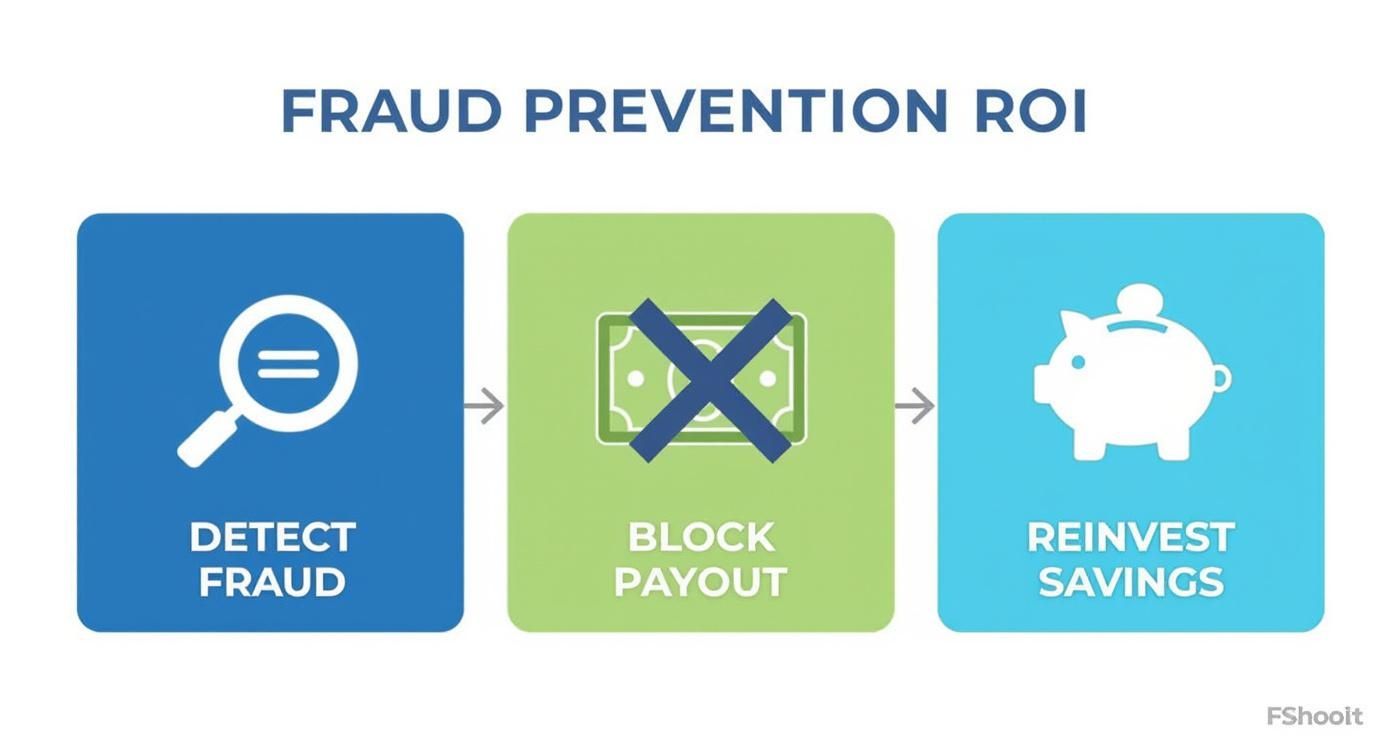
This process shows how stopping fraudulent payouts directly creates savings that can be channelled back into better detection tools. This creates a virtuous cycle of improvement and it is this reinvestment that sustains and strengthens your anti-fraud framework over the long haul.
Got Questions About Fraud Prevention?
Diving into the world of fraud prevention can bring up some practical questions. Let's tackle some of the most common ones to clarify how modern anti-fraud measures actually work and the real-world impact they have on insurers and customers.
How Does This Technology Affect Honest Customers?
For an honest customer, great fraud prevention technology should be almost invisible. Modern systems for verifying identities and items are designed to be quick and seamless, adding next to no friction when someone is applying for a policy or making a claim.
In fact, it often works the other way around. By quickly and accurately verifying genuine customers from the start, insurers can fast-track their applications and claims, leading to a much smoother, faster experience. The goal is to create hurdles for fraudsters, not for legitimate policyholders. Ultimately, cutting the costs of fraud helps keep premiums down for everyone.
What’s the Single Most Effective Step to Reduce Fraud?
While a multi-layered approach is always best, the single most effective thing an insurer can do is implement robust, data-driven verification right at the point of application. It is far more cost-effective to stop a fraudster from ever getting on your books than to try and catch them later during a claim.
Using technology to verify an applicant's identity, check for previous fraudulent activity and confirm the existence and condition of the insured assets creates a formidable barrier from day one. This proactive stance deters a huge amount of both opportunistic and organised fraud before it even starts.
Is It Expensive to Implement Modern Anti-Fraud Systems?
There is an initial investment, of course, but it is crucial to see it in the context of its return. The cost of undetected insurance fraud is immense, covering not just the fraudulent payouts but also the heavy costs of investigation and the significant damage to your reputation. The cost to the industry and thus to policyholders is substantial.
Leading providers consistently find that the savings from prevented fraud far outweigh the technology costs. The Association of British Insurers estimates that the industry spends over £200 million a year fighting fraud; effective technology ensures this investment delivers a massive return by slashing overall losses.
Take the first step towards building a more secure and efficient claims process. Discover how Proova can help you verify assets and deter fraud before it impacts your business. Visit https://www.proova.com to learn more.



